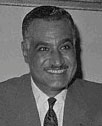Co-editors: Seán Mac Mathúna • John Heathcote
Consulting editor: Themistocles Hoetis
Field Correspondent: Allen Houglande-mail: thefantompowa@fantompowa.org

|

Most people assumes that when Nazi's fled Europe after the war most of them went to Latin America, where the ruling elite's - such as the Peron's in Argentina - had always been sympathetic to Nazi ideology. Many did, but a sizable number of others find work in Egypt, notably under the regime of Gamal Abdal Nasser (1918-1970), an Egyptian army officer and political leader, who was the first president of the republic of Egypt (1956-70). In 1952 he led the coup that deposed King Farouk (another Nazi sympathizer), and later became premier (1954), and president (1956). Hitler had enjoyed quite a following among the nationalist youth of Egypt during the war, after Nassiri Nasser, the brother of Gamal had published an Arab edition of Mein Kampf in 1939, describing its author as the "strongest man of Europe". The Nazi-Arab connection started by the Mufti of Jerusalem, Hajj Amin al-Husseini, continued after the war according to Nicholas Goodrick-Clarke writing in Hitler's Priestess: Savitri Devi, the Hindu-Aryan myth, and Neo-Nazism (New York University Press, New York, USA, 1998). The Middle East had emerged as a haven for Nazis fleeing Europe in the 1950s, which had its roots in the anti-British and pro-Nazi attitudes of Vichy Syria, Rashid Ali in Iraq, King Farouk of Egypt and the Mufti of Jerusalem. Thus, Egypt became like Argentina, a safe-haven for Nazi's fleeing justice and retribution from the Allies in Europe. Goodrick-Clarke states that King Farouk had been "impressed" by his garage mechanics recruited from Afrika Korps POWs, and: "Wondered what he might achieve with officers from elite units of the Gestapo and SS who had fought so hard against the hated British" (p174). Thus, a number of "nazi experts" who had escaped the Allied dragnet were hired by the King as military, financial and technical advisers. Although King Farouk was ousted in a military coup in January 1952, the Generals of the Egyptian armed forces were themselves "great admirers" of the Nazi's and "availed themselves of further large-scale imports of ex-Nazi expertise". They were to be helped by the former Luftwaffe ace Hans-Ulrich Rudel, the ex-SS commando Otto Skorzeny (1908-1975) and Eugen Dollman in recruiting "large numbers" of former Nazi fugitives from Argentina for key posts in the new republican regime in Egypt. It is Skorzeny who is generally credited with setting up the famous escape network to help Nazi war criminals escape Europe after the war, known as the ODESSA network. Thousands of Nazi war criminals benefited from his escape network (helped by the Vatican) and fled to Arab countries and Latin America between 1949 and 1952. The ODESSA network also had close links with the CIA - Skorzeny himself worked with the new West German intelligence service set up under CIA auspices by the former wartime German intelligence chief, Reinhard Gehlen. In fact, it was the leading CIA officer Allen Dulles who invited this SS war criminal to help reorganize the security forces of the new Egyptian Republic. Apparently, Skorzeny was approached by Mossad while living in Spain, in 1963, and agreed to provide information on Germans working in Egypt - especially rocket scientists. Mossad sent men who were said to have posed as 'NATO officials'. One possible explanation for the Nazi's co-operation may be that the CIA's James Jesus Angleton was responsible for links to other Western agencies, and had good relations with Israel and Mossad. Apparently, the CIA chief Allen Dulles asked Gehlen to inject some "life and expertise" into the Egyptian secret service: "Some former SS and Gestapo officers had been supplied, with a first batch of about 100 being enlisted by Otto Skorzeny in 1953" (Ian Black and Benny Morris, Israel's Secret Wars, p161) The first victims may have been Egyptian Jews and Communists, tortured by Gestapo experts. But the Nazi network spread through the Arab world (for instance Alois Brunner in Damascus), and later probably played a part in the pogroms and massacres against the Left in Iraq following the CIA (and Nasser) - backed coup there in 1963. As early as January 1952, the ODESSA network was in contact with "influential" Egyptian army officers and the former Grand Mufti of Jerusalem, Hajj Amin al-Husseini, who had lived in Egypt since the fall of Nazi Germany. According to the Israeli intelligence agency MOSSAD and French intelligence files, numerous former SS officers held key positions in the secret service and political police in Egypt. These included:
Added to this were a number of former Nazi officials and sixty military experts, mostly former Waffen-SS men, who assisted in the training of the Egyptian army. Several of them were also linked in 1958 with the then Algerian government-in-exile. At least 200 German and Austrian scientists and other personnel were deployed in the new aircraft and missile centre at Helwan, where new staff physician was Dr. Hanns Eisele, SS Captain and medical torturer in the death camp at Buchenwald. Goodrick-Clarke says that President Gamal Abdel Nasser was "well disposed" towards the Nazis, all the more because they wished to take part in the destruction of Israel. The presence of so many Nazi's in Egypt under the Nasser regime was exposed in the world press in October 1962, and precipitated a crisis in the Israeli government (who had ordered MOSSAD to make try and kill several of the Nazi's), and embarrassment in West Germany, over the exposure of postwar Nazi collaboration with the Nasser regime. Not surprisingly, the few remaining Egyptian Jews fled. From population of 75,000 Jews in 1948, by 1974 only 350 remained. In 1956, 4000 Jews were expelled, after being forced to renounce all property rights and financial claims. In 1957, all Egyptian Jews not in "continuous residence" since 1900 were deprived of citizenship. In 1960, many synagogues were closed down, along with Jewish orphanages, schools, hospitals and old peoples homes; and in 1967, all Jews in official positions were dismissed, with many more tortured and expelled, according to Martin Gilbert, author of The Routledge Atlas of Jewish History (Routledge, London, 1995). © 1999. Thanks to Charles Pottins. |
|
|
|